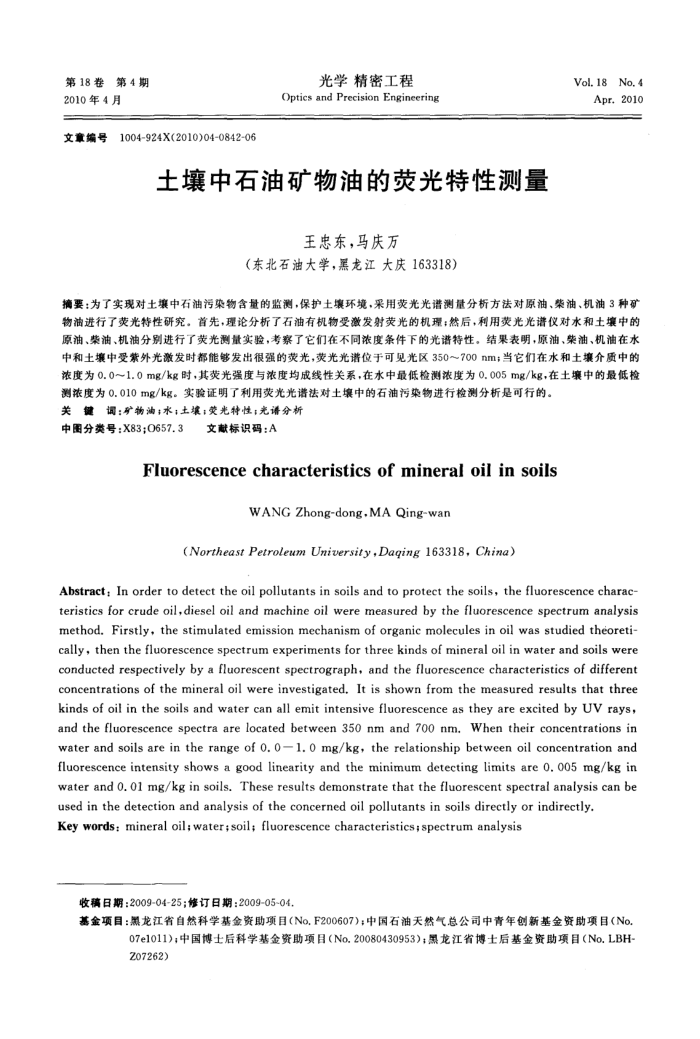您当前的位置:首页>论文资料>土壤中石油矿物油的荧光特性测量
内容简介
 第18卷
第18卷第4期
2010年4月
文章编号
1004-924X(2010)040842-06
光学精密工程
Optics and Precision Engineering
土壤中石油矿物油的荧光特性测量
王忠东,马庆万
(东北石油大学,黑龙江大庆163318)
Vol.18No.4 Apr.2010
摘要:为了实现对土壤中石油污染物含量的监测,保护土壤环境,采用荧光光谱测量分析方法对原油、柴油、机油3种矿物油进行了荧光特性研究。首先,理论分析了石油有机物受激发射荧光的机理;然后,利用荧光光谱仪对水和土壤中的原油、柴油、机油分别进行了荧光测量实验,考察了它们在不同浓度条件下的光谱特性。结果表明,原油、油、机油在水中和土中受紫外光激发时都能够发出很强的荧光,荧光光谱位于可见光区350~700nm;当它们在水和土壤介质中的浓度为0.0~1.0mg/kg时,其荧光强度与浓度均成线性关系,在水中最低检测浓度为0.005mg/kg,在土壤中的最低构
测浓度为0.010mg/kg。实验证明了利用荧光光谱法对土壤中的石油污染物进行检测分析是可行的。关键调:矿物油;水;土壤;荧光特性;光谱分析
中图分类号:X83;0657.3
文献标识码:A
Fluorescencecharacteristicsofmineraloilinsoils
WANG Zhong-dong,MA Qing-wan
(NortheastPetroleumUniersity,Daqing163318,China)
Abstract: In order to detect the oil pollutants in soils and to protect the soils, the fluorescence charac teristics for crude oil,diesel oil and machine oil were measured by the fluorescence spectrum analysis method. Firstly, the stimulated emission mechanism of organic molecules in oil was studied theoreti-cally, then the fluorescence spectrum experiments for three kinds of mineral oil in water and soils were conducted respectively by a fluorescent spectrograph, and the fluorescence characteristics of different concentrations of the mineral oil were investigated. It is shown from the measured results that three kinds of oil in the soils and water can all emit intensive fluorescence as they are excited by UV rays, and thefluorescencespectra arelocated between 35o nmand 7oo nm.When their concentrations in water and soils are in the range of o. O1. O mg/kg, the relationship between oil concentration and fluorescence intensity shows a good linearity and the minimum detecting limits are O. 005 mg/kg in water and o. O1 mg/kg in soils. These results demonstrate that the fluorescent spectral analysis can be
used in the detection and analysis of the concerned oil pollutants in soils directly or indirectly Key words: mineral oil;water;soil; fluorescence characteristics; spectrum analysis
收稿日期:2009-04-25;修订日期:2009-05-04,
基金项目:黑龙江省自然科学基金资助项目(No.F200607);中国石油天然气总公司中青年创新基金资助项目(No.
07e1011);中国博士后科学基金资助项目(No.20080430953);黑龙江省博士后基金资助项目(No.LBH-207262)
上一章:压电旋转驱动器制作及性能测试
下一章:填充介质的厚屏频率选择表面传输特性